
Welcome to Asian SignBank

The Asian SignBank was awarded as an Innovative Practice of the Zero Project 2018, for providing a practical solution to improve accessibility for persons with disabilities. For more information about the award, please see the factsheet or the Zero Project website.
| Background | |
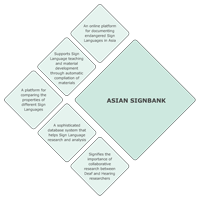 The Asian SignBank is an online database developed for sign language research. The idea, initiated by the Centre for Sign Linguistics and Deaf Studies, was realized by the joint effort of the Department of Linguistics and Modern Languages, CUHK and the Department of Systems Engineering and Engineering Management, CUHK. Tiding the efforts from two ends of research disciplines, the Asian SignBank was constructed on the philosophical ground of Sign Linguistics and assembled through the technical implementation of Systems Engineering.
The Asian SignBank is an online database developed for sign language research. The idea, initiated by the Centre for Sign Linguistics and Deaf Studies, was realized by the joint effort of the Department of Linguistics and Modern Languages, CUHK and the Department of Systems Engineering and Engineering Management, CUHK. Tiding the efforts from two ends of research disciplines, the Asian SignBank was constructed on the philosophical ground of Sign Linguistics and assembled through the technical implementation of Systems Engineering.The Asian SignBank is not a Sign writing system design to reflect representation of the sign language system which has an effect of promoting sign language literacy. The Asian SignBank is an online database developed with a significant research purpose which is to facilitate componential analysis and storage of sign entries. The application side yet is to facilitate sign language teaching and materials development, as well as Asian Sign Language research. The Asian SignBank targets on documenting sign language data from Asia Pacific Region Researchers from the Asian countries participating in the research and training program contribute to data input, the foundation of the Asian SignBank. | |
 Back to Top Back to Top |
| The APSL Program and Asian SignBank | |
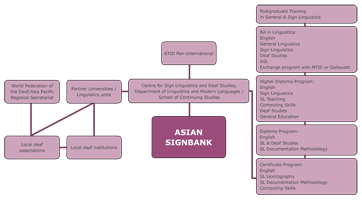 The Asian SignBank serves as a central reservoir of research data obtained in the Asia-Pacific Sign Linguistics Research and Training Program (http://www.cslds.org/apsl).
The Asian SignBank serves as a central reservoir of research data obtained in the Asia-Pacific Sign Linguistics Research and Training Program (http://www.cslds.org/apsl).
| |
 Back to Top Back to Top |
| Deaf and Hearing Collaboration | |
| The Asian SignBank and its related functions have high pedagogical and research value for sign language teachers, interpreters, social workers and sign language researchers. More important still, the Asian SignBank signifies the importance of collaborative research between the Deaf and Hearing researchers through the APSL Program, which aims to provide Sign Linguistics training to Deaf researchers, for them to contribute to the construction of the Asian SignBank and to design teaching materials and dictionaries to support the Sign Language research and training development of their countries. | |
 Back to Top Back to Top |
 |
 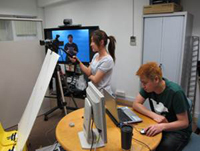 |
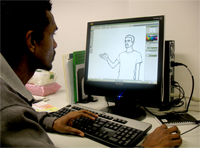 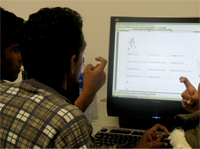 |
||
| Deaf and hearing researchers are discussing the features of signs | Hong Kong deaf and hearing researchers are shooting video of signs | Sri Lankan deaf researchers discuss and manipulate photos taken for the Asian SignBank |
| Benefits to Sign Language Research | |
|
Asian SignBank can facilitate Sign Linguistics research in the following ways:
| |
 Back to Top Back to Top |
| Long-term Significance | |
| |
 Back to Top Back to Top |
| Philosophical and Technical Frame | |
The sign notation system used in the Asian SignBank is based on a feature analysis approach according to the prosodic model proposed by Brentari (1998).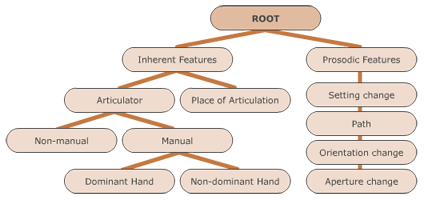
| |
 Back to Top Back to Top |
| Acknowledgement | |
 We would like to acknowledge the generous support of The Nippon Foundation in this research project, without which the hope of implementing deaf training in Sign Linguistics and developing a platform for documenting Asian sign languages would never be achieved. | |
 Back to Top Back to Top |
| Research and Production Team | |
| Our thanks also go to the Deaf and hearing researchers, who assisted in identifying linguistic information of the signs, serving as models for photos and video recordings, as well as enhancing the photos with graphics. | |
 Back to Top Back to Top |
Hong Kong 

Research team:
Brenda Yu
Felix Sze
Jafi Lee
Joe Mak
Kenny Chu
Michael Choi
Zoe Li
Yuan Rui Fang
Zhang Hong Bin
System development:
Cheng Ka Yiu
Chan Chun Kit
Cheung Yu Wai)
Chow Man Ki
Lau Wai Hung
Yu Man Him
Photo editing and Data processing:
Han Yijun
Jessica Yeung
Herman Kwan
Carmen Ip
Dong Dan
Hao Yuan
Liu Dong Qi
Samuel Cold
Susan Wong
Zhang Huan
Brenda Yu
Felix Sze
Jafi Lee
Joe Mak
Kenny Chu
Michael Choi
Zoe Li
Yuan Rui Fang
Zhang Hong Bin
System development:
Cheng Ka Yiu
Chan Chun Kit
Cheung Yu Wai)
Chow Man Ki
Lau Wai Hung
Yu Man Him
Photo editing and Data processing:
Han Yijun
Jessica Yeung
Herman Kwan
Carmen Ip
Dong Dan
Hao Yuan
Liu Dong Qi
Samuel Cold
Susan Wong
Zhang Huan
Indonesia 

Research team:
Adhi Kusumo Bharoto
Adhika Irlang Suwiryo
Laura Lesmana Wijaya
Iwan Satryawan
Silva Tenrisara Pertiwi Isma
Adhi Kusumo Bharoto
Adhika Irlang Suwiryo
Laura Lesmana Wijaya
Iwan Satryawan
Silva Tenrisara Pertiwi Isma
Sri Lanka 

Research team:
Kodithuwakku Koraralege Brayan Susantha
Liyanage Sumudu Sulochana Perera
Mataramba Kanatta Gamage Geshani Amila
Mohamed Ramees Mohammed Razak
Pubodha Sarani Kanakkahewa
Kodithuwakku Koraralege Brayan Susantha
Liyanage Sumudu Sulochana Perera
Mataramba Kanatta Gamage Geshani Amila
Mohamed Ramees Mohammed Razak
Pubodha Sarani Kanakkahewa
Vietnam 

Research team:
Ho Thu Van
Le Thi Thu Huong
Luu Ngoc Tu
Nguyen Dinh Mong Giang
Nguyen Hoang Lam
Nguyen Minh Nhut
Nguyen Thi Hoa
Nguyen Tran Thuy Tien
Pham Van Hai
Ho Thu Van
Le Thi Thu Huong
Luu Ngoc Tu
Nguyen Dinh Mong Giang
Nguyen Hoang Lam
Nguyen Minh Nhut
Nguyen Thi Hoa
Nguyen Tran Thuy Tien
Pham Van Hai
Japan 

Research team:
Endo Eita
Furukawa Kaori
Ikeda Masumi
Imai Mika
Isobe Daigo
Odaka Mayumi
Shimotani Natsuko
Endo Eita
Furukawa Kaori
Ikeda Masumi
Imai Mika
Isobe Daigo
Odaka Mayumi
Shimotani Natsuko
Fiji 

Research team:
Tinai Asinate
Tinai Asinate
Myanmar 

Research team:
Ei Zin Phyo
Naw Nobel
Shwe Sin
Soung Yein
Tin Aye Ko
Wai Hnin Thant
Ei Zin Phyo
Naw Nobel
Shwe Sin
Soung Yein
Tin Aye Ko
Wai Hnin Thant
